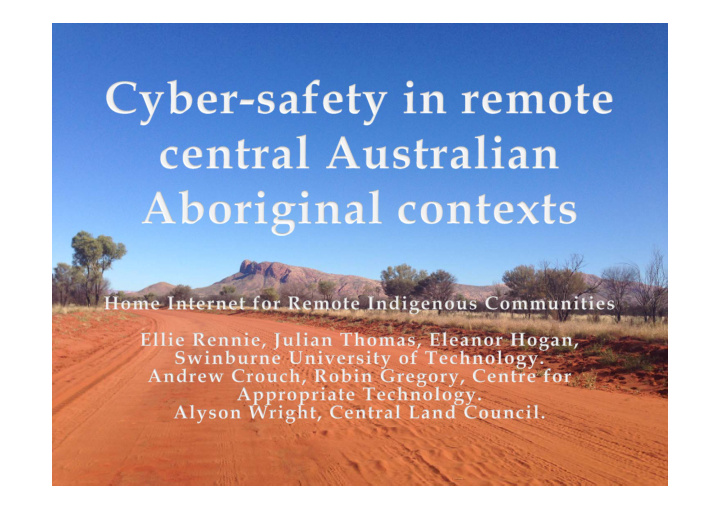



Map of central Australia
Cyberbullying in Tennant Tennant Creek: Most people did not think the incidence of cyberbullying there ‘was different to anywhere else’ and emphasised that cybersafety was a problem ‘world-wide’. Mainly older primary school age to mid-thirties, through texting and messaging on Facebook and Divas Chat. Primarily associated with mobile phone usage. Concurs with findings of FaHCSIA’s Community Safety and Wellbeing Research Study (2011): cyberbullying only significant in places with mobile coverage. HIP communities: no mobile coverage, no cybersafety issues
Remote Indigenous cybersafety challenges Lack of understanding of privacy – remote people unaware that ‘anybody in the world can see them’ online . Capacity to enter others’ personal space rapidly across vast distances to breach social and cultural protocols and boundaries; Potential to inflame existing tensions, possibly more so in places with high levels of social problems; Inter-racial: ‘some really nasty racist fights on Facebook where the non-Aboriginal community link to the Aboriginal community [especially round football]’. [SP] Potential vulnerability to identity theft, scams, fraud, etc. Impact of digital footprint on employability: ‘There are enough barriers to Aboriginal employment already.’ [PB] Increasing digital and cultural disconnects between older and younger generations.
Mobiles & cyber-bullying Comparative autonomy of the mobile phone ‘It [cyberbullying] definitely happens the most around the mobile,’ she said, ‘because you don’t have your other family members logging onto the same desktop, and being able to go into other people’s [accounts] … You can do what you want on your own phone.’ [KB] Immediate access to peer validation ‘All the people that they’re into, all the bands that they’re into, all the stuff that they want to do, everything’s about social media. So I think that is why they’re starting a lot earlier because if you don’t get into it early, then you feel like you’re an outcast.’ [NT schools]
Mobile phones — advantages Older women – emergencies, sorry business. Useful as safety devices for kids; one older woman suggested there wasn’t the same need as in a city. Maintaining family and social contacts across distances ( cf. Brady, Dyson & Asela (2008, 2009); Relative cheapness & convenience (prepaid billing), and portability, especially for highly mobile people.
Social media positives Ability to maintain connections despite the ‘tyranny of distance’: ‘keeping up with the rels in Lajamanu’. ‘Facebooking’ contacts and staff. Finding a lost child. Incentive to improve literacy: keeping up with the digital Joneses. Responding to racism [local community]: opportunities to ‘have conversations about racism directly and openly.’
Responding to Indigenous cybersafety challenges Potential to focus on the negative aspects of ICTs: fear of an ‘electronic invasion.’ Overlook the benefits of digital technology, especially for remote Aboriginal people. Existing inequalities experienced by remote Aboriginal people may be exacerbated if they are not provided with opportunities to enjoy the same benefits from ICTs as non-Indigenous Australians.
Double remoteness NT Remote Aboriginal populations: characterised by double remoteness—lack of access to physical and digital resources ’at the widest point of the digital divide’: Census 2011: 75 % of remote NT Indigenous people did not have • an internet connection at home. Cf. 14 % of the Australian population lacked home internet access • in 2013. CLC and Tangentyere Council (2007): 56 per cent of central • Australian Aboriginal people owned mobile phones.s 2011 Census: 11 locations in the southern NT had mobile phone • coverage.
Intergenerational challenge Indigenous youth’s ICT competence: ‘is defining a generational identity distinct from that of their elders, with new media representing a site where youths are exhibiting agency and a technological expertise that exceeds that of the older generation.’ ( Kral (2011), Ngaanyatjarra lands research ) Heightened sense of a digital divide between older and younger people in remote areas. Underlying challenge of digital citizenship.
Digital citizenship ACMA (2010) defines cybersafety as: ‘exposure to illegal or inappropriate material, stranger danger, identity theft, invasion of privacy, harassment and cyberbullying’. Griffith University’s 2011 evaluation of the ACMA Cybersmart Outreach Program: Need to broaden focus on cybersafety from ‘fear and safety’, • protectionist paradigm to a celebratory concept of digital citizenship that promotes • positive values in online communities like ‘belonging, citizenship, connectedness, collaboration, community ’.
‘Digi-smart’ responses Prevention Educational – Mainstream: ThinkUKnow; CyberSmart. • Indig-specific: ACMA, Be Deadly Online ; NT DoJ ‘Strong • Choices project: B2M (Tiwi); ‘Codey’ avatar (TC). Intervention Identification of underage and false profiles on Divas • Chat; closed via AFP and AirG. Divas Cops chat room monitors. • CERP mediation. •
Codey cybersafety project http://barklyarts.com.au/codey-cyber-safety-project/ CODEY’S DIGI DEADLY’S How to be digital smart! NO HUMBUG KEEP IT REAL Humbugging your family for money Be yourself on the internet, making or pin numbers of their basic card false profiles is wrong. to buy Internet credit, is wrong. Don’t use the Internet as a mask to Humbugging people online for hide behind to say and do things information or teasing, is wrong. that are hurtful. Respect your family. Respect yourself. BE POWER WISE NO DIGI PAYBACK Plugging in your phone at home to Don’t use it as a weapon to hurt get on the Internet uses power and others. Typing behind a screen, costs money. Power at home is for does not make you invincible. If you everyone to share and must be hurt someone or their community, respected. that will have a real affect on you Respect your time. and your family. Respect your community.
Indigenous Acknowledgment Swinburne University of Technology recognises the historical and cultural significance of Australia’s Indigenous history and the role it plays in contemporary education Each day in Australia we all walk on what was once traditional Indigenous land We therefore acknowledge the traditional custodians of the land we all currently occupy here at the Hawthorn campus, the Wurundjeri people, and pay respect to Elders past and present, including those from other clans who now reside on Wurundjeri land.
Recommend
More recommend